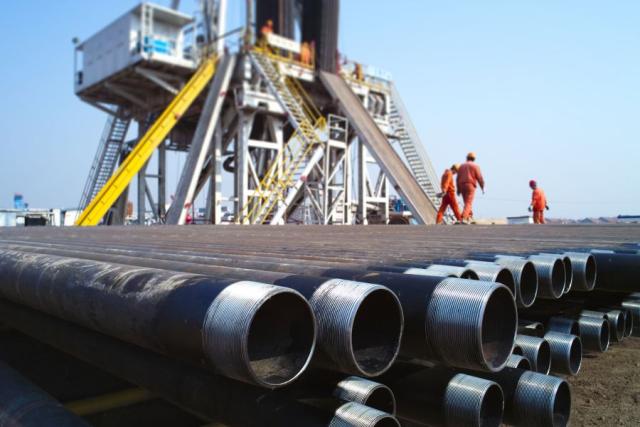
While there is a positive outlook for demand in the global land rig market, Westwood warns the oversupply of rigs will remain a factor in the sector. (Source: Shutterstock.com)
Westwood Global Energy Group consultants foresee a healthy recovery roadmap for the global land rig market, driven by higher commodity pricing and pressures around energy security.
According to Westwood’s latest analysis, many regions will likely recover from the dramatic global downturn throughout 2020 better than previously expected.
In 2020, onshore global well drilling dropped to a low of 39,000, while activity in 2022 is expected to reach 49,600 before climbing to 60,000 wells in 2026, the firm said.
“It’s encouraging to see the market begin to get back on its feet after the setbacks from 2020 and 2021, but there will still be significant oversupply of rigs globally, which we expect to see throughout the forecast period,” said Todd Jensen, research analyst of onshore energy services at Westwood, in a report published Aug. 25.
Jensen attributed much of the positive outlook to the need for energy security and sanctions imposed on Russia following its invasion of Ukraine leading to higher-than-expected oil and gas prices.
Land drill rig day rates have increased in a number of regions due to an increase in drilling demand combined with higher commodity pricing, Westwood said.
The U.S. has seen day rates increase by 25% during 2022, with average day rates for the second quarter of 2022 reaching $26,500, according to Westwood. Tight supply for super-spec Tier 1 automated rigs in the U.S. have led to day rates in the mid-$30,000s, the firm added.
Outside of the U.S., countries such as Colombia and Oman are also experiencing high demand for high-spec rigs, with Colombia seeing day rates reaching $45,000 for units with automation capabilities, Westwood said.
Westwood cautions that the increased focus on automated rigs, which currently account for just 16% of the overall rig fleet, could lead to demand outweighing supply of these rigs, a trend that is already being noted in the U.S. specifically, where some drilling contractors are expecting to exhaust their available supplies of super-spec rigs by mid-2023.
At the same time, regions such as the Middle East have more stable pricing due to longer term contracts and the presence of national oil company-owned rig fleets, Westwood noted.
While there is a positive outlook for demand, Westwood said the oversupply of rigs will remain a factor in the sector, with demand unlikely to return to the pre-2014 downturn levels that led to a surge in newbuild rig construction. While utilization in 2022 has increased to 45%, from 43% in 2021, and is forecast to grow to 53% by 2026, numbers will remain well below maximum capacity, the firm added.
Westwood also said it expects operators to remain wary of threats such as rapid changes in commodity pricing and the pricing of drilling materials such as drill pipe and frac sands.
Overall, Westwood projects the number of wells drilled from 2022 to 2026 to strongly increase year-on-year, reaching upwards of 60,000 in 2026, compared to 49,600 in 2022. Westwood estimates 4,070 rigs on average will be operational in 2022, growing to 5,050 by the end of the forecast in 2026, representing an increase of 24%.
China, the GCC (Gulf Cooperation Council) countries, Russia and the U.S. account for approximately 80% of forecast rig demand, Westwood said. Activity in the U.S. is expected to make a strong return, as the country prioritizes energy security and operators look to benefit from the high oil and gas prices, according to Westwood.
China is likely to account for the greatest share of wells drilled and should see continued robust levels of drilling activity, while a strong growth in demand is also expected from the GCC countries, the firm said.
Russia, the third largest driller globally, is expected to see a decrease in the first year of the forecast before a slow recovery, although Westwood cautions that Russian activity will depend on the outcome of the war in Ukraine.
Jennifer Pallanich contributed to this article.
Recommended Reading
BP Restructures, Reduces Executive Team to 10
2024-04-18 - BP said the organizational changes will reduce duplication and reporting line complexity.
Matador Resources Announces Quarterly Cash Dividend
2024-04-18 - Matador Resources’ dividend is payable on June 7 to shareholders of record by May 17.
EQT Declares Quarterly Dividend
2024-04-18 - EQT Corp.’s dividend is payable June 1 to shareholders of record by May 8.
Daniel Berenbaum Joins Bloom Energy as CFO
2024-04-17 - Berenbaum succeeds CFO Greg Cameron, who is staying with Bloom until mid-May to facilitate the transition.
Equinor Releases Overview of Share Buyback Program
2024-04-17 - Equinor said the maximum shares to be repurchased is 16.8 million, of which up to 7.4 million shares can be acquired until May 15 and up to 9.4 million shares until Jan. 15, 2025 — the program’s end date.





